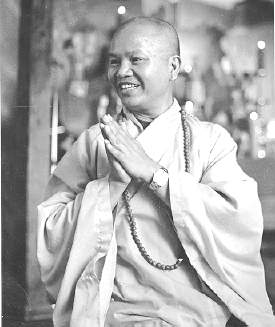- Ven. Dr. Thich Thien-An
- September 1926 - November 1980
Text by Sarika Dharma
Photo scanned by Ed Craig
Ven. Dr. Thich Thien-An came to Southern California in the summer of 1966 as an
exchange professor at UCLA. Soon his students discovered he was not only a renowned
scholar, but a Zen Buddhist monk as well. His students convinced Dr. Thien-An to teach the
practice of meditation and start a study group about the other steps on the Buddhist path,
in addition to  the academic viewpoint.
the academic viewpoint.
Several years later, his enthusiastic followers encouraged Ven. Thien-An to apply for
permanent residence and start a meditation center that included place for practitioners to
live. Twenty-six years later, The International Buddhist Meditation Center continues to
thrive.
The IBMC today consists of six houses on a residential street several miles west of
downtown Los Angeles. Suto, as his students called him, believed in the importance of
being accessible to those who face the dukkha of city living. Two of the houses in the
compound are named for Vietnamese monks
who self-immolated to bring the attention of the world to the horrors of the situation
in Vietnam, an act which ultimately led to the downfall of the hated Diem regime. One of
those monks, Ven. Tieu-Dieu, was Suto's father.
Suto was born in Hue and grew up in a Buddhist family. Even as a young boy, he would
imitate the chanting and ceremony of the monks who came to their house to give blessings
and receive dana. He entered the monastery at the age of 14 and continued his education,
finally receiving a Doctor of Literature degree at the prestigious Waseda University in
Japan. He then returned to Vietnam to found a university there.
Ven. Thien-An's vision of his work in the U.S. was to bring Buddhism into another
culture, as always adapting to the national values and understandings. He understood the
American mind and culture and had a sense of how the practice needed to differ for
Americans to develop. He mentioned often how the West would eventually bring Buddhism back
to the East.
When Saigon fell in 1975, Ven. Thien-An saw his responsibility and helped the boat
people and other refugees from his homeland. The center became a residence for as many of
the displaced as possible. Networking was done to ensure help for the others. The American
monks joined with Vietnamese monks to do this Bodhisattva work.
The fleeing Vietnamese, having left all their material belongings as well as family and
friends behind, were so relieved to find Buddhists when they got off the ships that many
of them cried. Suto opened the first
Vietnamese Buddhist temple in the United States. Eventually, he became the First
Patriarch of Vietnamese Buddhism in America.
Suto's vision of Buddhism in America included a softening of the lines between
different Buddhist traditions, and the Center has always included teachers from Theravada,
Mahayana and Vajrayana traditions, as well as monks and students from many different
countries. He encouraged interfaith as well as interBuddhist activities, and provided
opportunities for students who wished to become dharma teachers and continue to live the
householder's life, rather than becoming monastics. Many American monks and nuns were also
ordained, and a number of his disciples still continue his work, both at the IBMC and
other centers.
Dr. Thien-An died at the age of 54 of cancer which had spread rapidly throughout his
body, from his liver to his brain. In his last months, one could often find him sitting
peacefully on the steps of the bell tower. It was a gift to be able to sit quietly next to
him and feel the energy of his understanding. He had many plans but saw the reality of
what was happening. He smiled, as he smiled often, a smile of great compassion and
loving-kindness for all the world.